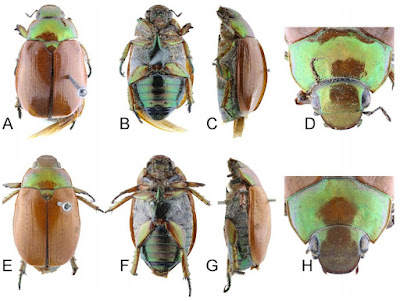 |
An adult female of Troglodiplura sp. ‘MYG602’.
in Harvey, Rix, Hillyer & Huey, 2020. |
Abstract
Compared with araneomorph spiders, relatively few mygalomorph spiders have evolved an obligate existence in subterranean habitats. The trapdoor spider genus Troglodiplura Main, 1969 and its sole named species T. lowryi Main, 1969 is endemic to caves on the Nullarbor Plain of southern Australia, and is one of the world’s most troglomorphic mygalomorph spiders. However, its systematic position has proved to be difficult to ascertain, largely due to a lack of preserved adults, with all museum specimens represented only by cuticular fragments, degraded specimens or preserved juveniles. The systematic placement of Troglodiplura has changed since it was first described as a member of the Dipluridae, with later attribution to Nemesiidae and then back to Dipluridae. The most recent hypothesis specifically allied Troglodiplura with the Neotropical subfamily Diplurinae, and therefore was assumed to have no close living relatives in Australia. We obtained mitochondrial sequence data from one specimen of Troglodiplura to test these two competing hypotheses, and found that Troglodiplura is a member of the family Anamidae (which was recently separated from the Nemesiidae). We also reassess the morphology of the cuticular fragments of specimens from several different caves, and hypothesise that along with T. lowryi there are four new troglobitic species, here named T. beirutpakbarai Harvey & Rix, T. challeni Harvey & Rix, T. harrisi Harvey & Rix, and T. samankunani Harvey & Rix, each of which is restricted to a single cave system and therefore severely threatened by changing environmental conditions within the caves. The first descriptions and illustrations of the female spermathecae of Troglodiplura are provided. The family Anamidae is further divided into two subfamilies, with the Anaminae Simon containing Aname L. Koch, 1873, Hesperonatalius Castalanelli, Huey, Hillyer & Harvey, 2017, Kwonkan Main, 1983, Swolnpes Main & Framenau, 2009 and Troglodiplura, and the Teylinae Main including Chenistonia Hogg, 1901, Namea Raven, 1984, Proshermacha Simon, 1909, Teyl Main, 1975 and Teyloides Main, 1985.
Keywords: Australasia, Avicularioidea, molecular phylogenetics, Nemesioidina, taxonomy.
Family Anamidae Simon, 1889
Subfamily Teylinae Main, 1985, stat. nov.
Included genera: Chenistonia Hogg, 1901, Namea Raven, 1984, Proshermacha Simon, 1909, Teyl Main, 1975 and Teyloides Main, 1985.
Subfamily Anaminae Simon, 1889
Included genera: Aname L. Koch, 1873, Hesperonatalius Castalanelli, Huey, Hillyer & Harvey, 2017, Kwonkan Main, 1983, Swolnpes Main & Framenau, 2009 and Troglodiplura Main, 1969 (the latter tentatively included; see Results and Discussion, above).
Genus Troglodiplura Main, 1969
Type species: Troglodiplura lowryi Main, 1969, by monotypy.
Troglodiplura lowryi Main, 1969
Troglodiplura challeni Harvey & Rix, sp. nov.
Etymology: This species is named for Dr Craig Challen, in recognition of his contributions to cave diving and in particular his role in the rescue of 12 students and their coach from Tham Luang Nang Non cave, Thailand, in 2018.
Troglodiplura harrisi Harvey & Rix, sp. nov.
Etymology: This species is named for Dr Richard Harris, in recognition of his contributions to cave diving and in particular his role in the rescue of 12 students and their coach from Tham Luang Nang Non cave, Thailand, in 2018.
Troglodiplura beirutpakbarai Harvey & Rix, sp. nov.
Etymology: This species is named for the late Beirut Pakbara, who assisted in the rescue of 12 students and their coach from Tham Luang Nang Non cave, Thailand, in 2018, but tragically died from a resulting infection in 2019.
Troglodiplura samankunani Harvey & Rix, sp. nov.
Etymology: This species is named for the late Saman Kunan (1980–2018), in memory of his role in the rescue of 12 students and their coach from Tham Luang Nang Non cave, Thailand, in 2018.
 |
An adult female of Troglodiplura sp. ‘MYG602’.
|
Troglodiplura sp. ‘MYG602’
Mark S. Harvey, Michael G. Rix, Mia J. Hillyer and Joel A. Huey. 2020. The Systematics and Phylogenetic Position of the Troglobitic Australian Spider Genus
Troglodiplura (Araneae : Mygalomorphae), with A New Classification for Anamidae.
Invertebrate Systematics. 34(8);
799-822. DOI:
10.1071/IS20034 B. Y. Main.1969. A blind mygalomorph spider from a Nullarbor Plain cave. Journal and Proceedings of the Royal Society of Western Australia. 52: 9–11.
Rare species of cave-dwelling spiders named in honour of Thai cave rescuers














































